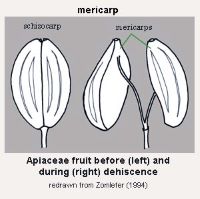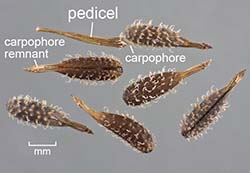Content is from Kirkbride et al. 2006Kirkbride et al. 2006:
Kirkbride JH, Jr, Gunn CR, and Dallwitz MJ. 2006. Family guide for fruits and seeds, vers. 1.0. Accessed September 2020-January 2022. URL: https://nt.ars-grin.gov/seedsfruits/keys/frsdfam/index.cfm ., without modification.
Updates are forthcoming.
Kirkiaceae (Engler) Takhtajan
Common name: Kirkia Family.
Number of genera: 2 genera.
Number of species (Mabberley 1997): 3 species (Kirkia acuminata Oliv., K. wilmsii Engl., Pleiokirkia of Madagascar).
Fruits: Pistil(s) compound; 1; 1-pistillate; with carpels united. Fruit pericarpium; schizocarpschizocarp:
usually dry fruit splitting between two or more locules to form distinct, indehiscent, usually one seeded segments; fruit derived from a single, superior or inferior, compound ovary; compare to mericarp ; microbasarium; with persistent central column; solid central column shaft; valves diverging from top of central column (resembling umbrella ribs); with stylar remenant(s); at apexapex:
; microbasarium; with persistent central column; solid central column shaft; valves diverging from top of central column (resembling umbrella ribs); with stylar remenant(s); at apexapex:
the point farthest from the point of attachment, or the "tip" of an organ ; not within accessory organ(s); more than 1 but less than 10-seeded; 4–6-seeded; less than 1 cm long, or from 1–5 cm long; 0.6–2.5 cm long; with 8–12-carpellate; with carpels united; with carpels separating at maturity; with carpels not radiating at maturity; with carpels remaining connected at stylestyle:
; not within accessory organ(s); more than 1 but less than 10-seeded; 4–6-seeded; less than 1 cm long, or from 1–5 cm long; 0.6–2.5 cm long; with 8–12-carpellate; with carpels united; with carpels separating at maturity; with carpels not radiating at maturity; with carpels remaining connected at stylestyle:
in a flower, the narrow and elongated part of the pistil between the stigma and the ovary; sometimes persisting in fruit ; with sterilesterile:
; with sterilesterile:
lacking male and/or female reproductive parts; also, not producing fruit or seed
 carpels; without fleshy laterallateral:
carpels; without fleshy laterallateral:
(of embryo) embryo lies along the side of the seed, generally towards one end; of, at, or from the side; in grasses, can refer to the sides adjacent to the dorsal and ventral sides
appendage; not sulcatesulcate:
surface relief—having one or more elongate, relatively narrow and shallow depressions or grooves ; in transection triangulartriangular:
; in transection triangulartriangular:
2D shape—three relatively straight sides with distinct corners; more angular than teardrop-shaped ; 3-angled; apexapex:
; 3-angled; apexapex:
the point farthest from the point of attachment, or the "tip" of an organ not beaked; wall crustaceouscrustaceous:
not beaked; wall crustaceouscrustaceous:
texture—thin, dry, indurate, and brittle
to firm to woodywoody:
texture—consisting mainly of indurate lignified tissues, characteristic of or resembling wood
; indehiscentindehiscent:
not opening on its own, as in a fruit
 . Epicarpepicarp:
. Epicarpepicarp:
outer layer of fruit wall or pericarp, if divided into layers; note here used synonymously with exocarp brown (all shades); dulldull:
brown (all shades); dulldull:
reflecting only a low proportion of incident light, with no apparent sheen ; durable; crustaceouscrustaceous:
; durable; crustaceouscrustaceous:
texture—thin, dry, indurate, and brittle
; glabrousglabrous:
without hairs
, or not glabrousglabrous:
without hairs
(with hairs); hairs short; hairs not glandularglandular:
surface relief—covered with small, raised secretory glands, regular or irregularly shaped, translucent or opaque, and maybe distinctly colored ; without armature; smooth; with wing(s); 2-winged (permericarp, 8 per fruit); with wing(s) laterallateral:
; without armature; smooth; with wing(s); 2-winged (permericarp, 8 per fruit); with wing(s) laterallateral:
(of embryo) embryo lies along the side of the seed, generally towards one end; of, at, or from the side; in grasses, can refer to the sides adjacent to the dorsal and ventral sides
; without apicalapical:
at or pertaining to the end of the seed or fruit distal from its point of attachment (i.e., base)
respiratory hole. Mesocarpmesocarp:
the middle layer of the pericarp, if divided into layers present; dry and hard; composed of 1 unified layer; without lactiform cavity system; & endocarpendocarp:
present; dry and hard; composed of 1 unified layer; without lactiform cavity system; & endocarpendocarp:
the inner layer of the pericarp, if divided into layers sharply differentiated. Endocarpendocarp:
sharply differentiated. Endocarpendocarp:
the inner layer of the pericarp, if divided into layers present; not separating from exocarpexocarp:
present; not separating from exocarpexocarp:
outer layer of fruit wall or pericarp, if divided into layers; note here used synonymously with epicarp ; thin; not splitting into 1-seeded pyrenes; stone plurilocular; stone 8–12-loculate (in 4–6 mericarpsmericarp:
; thin; not splitting into 1-seeded pyrenes; stone plurilocular; stone 8–12-loculate (in 4–6 mericarpsmericarp:
a one-seeded section (carpel) of a schizocarp, as in Apiaceae fruits (compare schizocarp) ); smooth; without wing; without operculumoperculum:
); smooth; without wing; without operculumoperculum:
a dehiscent cap (or lid) of a seed or fruit that opens during germination or dehiscence ; without secretory cavities; without mechanism for seedling escape; with grooves; 3-grooved; without longitudinallongitudinal:
; without secretory cavities; without mechanism for seedling escape; with grooves; 3-grooved; without longitudinallongitudinal:
of or relating to length or the lengthwise dimension
ridges. Funiculusfuniculus:
(alt. funicle) stalk connecting the ovule (later seed) to the ovary (later fruit) placenta short; short without seed bearing hookswith hooks:
short; short without seed bearing hookswith hooks:
bristles or spines with curved or backwards pointing tips, or with secondary bristles along their length (retinacula); not persisting in fruit after seed shed.
(retinacula); not persisting in fruit after seed shed.
Seeds: Arilaril:
(broad sense) appendicular structure that wholly or partly envelops a seed and is produced from or a modification of the funicle, raphe, or outer integument; usually fleshy or pulpy, sometimes spongy or tufted-capillate, often brightly colored absent. Seed larger than minute; slightly curvedcurved:
absent. Seed larger than minute; slightly curvedcurved:
(of embryo) linear embryo is curved into an arch or horseshoe with the ends far apart ; in transection triangulartriangular:
; in transection triangulartriangular:
2D shape—three relatively straight sides with distinct corners; more angular than teardrop-shaped ; not bowl shaped; not nutlike; without winglike beakbeak:
; not bowl shaped; not nutlike; without winglike beakbeak:
a usually firm, terminal appendage, sometimes tapered ; without caudatecaudate:
; without caudatecaudate:
tapering to a long, tail-like appendage appendage(s); without canavanine. Sarcotestasarcotesta:
appendage(s); without canavanine. Sarcotestasarcotesta:
pulpy or fleshy outer layer of the seed coat, simulates aril absent. Testatesta:
absent. Testatesta:
seed coat
 present; without fleshy or leatheryleathery:
present; without fleshy or leatheryleathery:
texture—moderately thick, tough, and very pliable
layer over hard layer; without glands; without bristles; without wings; without collar; without operculumoperculum:
a dehiscent cap (or lid) of a seed or fruit that opens during germination or dehiscence ; colored; monochrome; not becoming mucilaginousmucilaginous:
; colored; monochrome; not becoming mucilaginousmucilaginous:
resembling mucilage; moist and sticky
when wetted. Embryo differentiated from food reserve; well developed; partially filling testatesta:
seed coat
 (with food reserve); at one end of seed not extending into a depression or cup; without coleorhiza; without simmondsin; without stomata; not green.
(with food reserve); at one end of seed not extending into a depression or cup; without coleorhiza; without simmondsin; without stomata; not green.
 suspended from the top of a central carpophorecarpophore:
suspended from the top of a central carpophorecarpophore: , each mericarpmericarp:
, each mericarpmericarp: with the remaining base of one of the previously coherent stylesstyle:
with the remaining base of one of the previously coherent stylesstyle: relaxed back over its apexapex:
relaxed back over its apexapex: ".
".
Literature specific to this family: Stannard, B. 1981. A revision of Kirkia (Simaroubaceae). Kew Bull 35:829–839; Wyk, B. van & P. van Wyk. 1997. Field guide to trees of southern Africa. Struik, Cape Town.
General references: Mabberley, D.J. 1987. The plant-book, 706 p. Cambridge University Press, Cambridge.